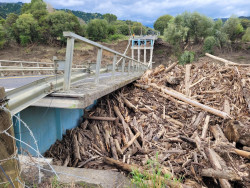Tairāwhiti has been struck by a series of severe weather events in the past year, leaving extensive damage across the region. The scale of damage is significant, and it will take time to repair. Find out more about the road ahead here.
Cyclone Gabrielle re-routed rivers across our highways, caused slips and dropouts, and severed critical highway connections. As we recover, our crews are working hard to restore and strengthen the highway network.
It’s a challenging time to travel around Tairāwhiti, with roads damaged and numerous work sites along our highways. Please check Journey Planner before you leave, drive with care, obey temporary speed limits and respect the instructions of roading crews.
The Hikuwai No. 1 Bridge, which connected Tokomaru Bay to State Highway 35, was destroyed in Cyclone Gabrielle. This road is a lifeline for Tokomaru Bay, Waipiro Bay and Te Puia Springs. Following the hard work of contractors and community support, on 15 June we opened the Hikuwai Bailey bridge.
Prior to this, since March, communities between Tokomaru Bay and Te Puia Springs had been reconnected to the south by the community-led Hikuwai Bypass Road (Pourau Road). This is a diversion road through private land, built by Kuru Contracting. Waka Kotahi supports this initiative and has worked with Ngāti Porou and landowners to enable the public to access this road. The road is classified as a secondary road as per the NZ Forest Owners Association (NZFOA) Road Engineering Manual guidelines. It is an unsealed one lane road, with laybys incorporated to alleviate congestion and ensure there are opportunities for vehicles to pass each other safely. This road will remain in use for heavier trucks which are unable to use the Bailey bridge.
In early April, a new Mangahauini Access Track was also opened, reconnecting people to the north. This Track is a 300-metre unsealed road and we ask motorists to drive with care. We’re committed to keeping this access route open, safe and operating for the community, but it may need to be closed at short notice in bad weather.

Hikuwai No 1 bridge
Waka Kotahi manages the region’s state highway network, and all other roads in the region are managed by local councils. For details on the condition of local roads, check the local council website:
The key links into and around Tairāwhiti have been reopened, and we’re using short-term measures to keep the region moving. Those include solutions like Bailey bridges, temporary speed limits and working around slips and dropouts by reducing the road to a single lane.
We are also now working on developing a strategic resilience recovery approach for Tairāwhiti, with Wairoa also included in this work. SH2 (Ōpōtiki to SH2/SH5 intersection), SH35 and SH38 are included in the project.
We are working closely with local councils on this project, which will further support the immediate emergency works that have already taken place. It will build on existing strategic work already done in the region, including the Tairāwhiti Roading Package, and applying a stronger resilience lens. It will also identify the potential initial broad programmes of recovery work to progress as soon as feasible, and the ranges of funding required.
All future programmes of work will be subject to securing funding, and many will require further investigation, planning and community engagement including consultation with those who live and work in the affected areas before physical works begin.
We’re committed to getting the recovery of the transport network right. We’re working with KiwiRail, Downer, Fulton Hogan and Higgins to establish the construction management team for the long-term recovery.
Local knowledge and resources will play a key role in the recovery and the collaborative delivery model will work together with iwi, councils, locally-owned contractors and consultants and the community – those who know Tairāwhiti best – to ensure we meet current and future needs.
The collaborative delivery model is expected to be in place for several years, and the full team is expected to be in place by mid-2023. Until then, ongoing recovery works to improve access levels are being undertaken by the existing maintenance contractors across affected regions.
More information on our response to Cyclone Gabrielle